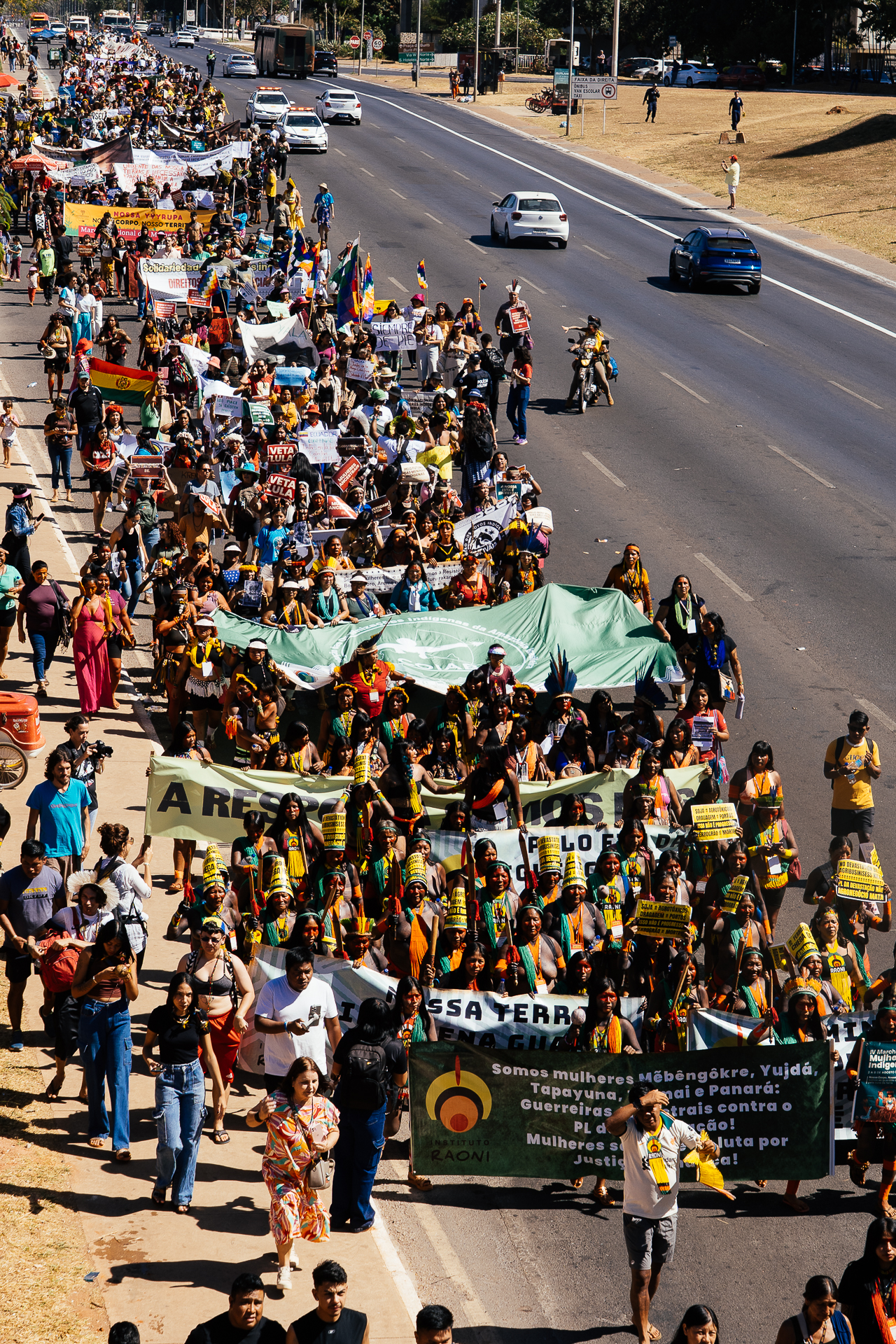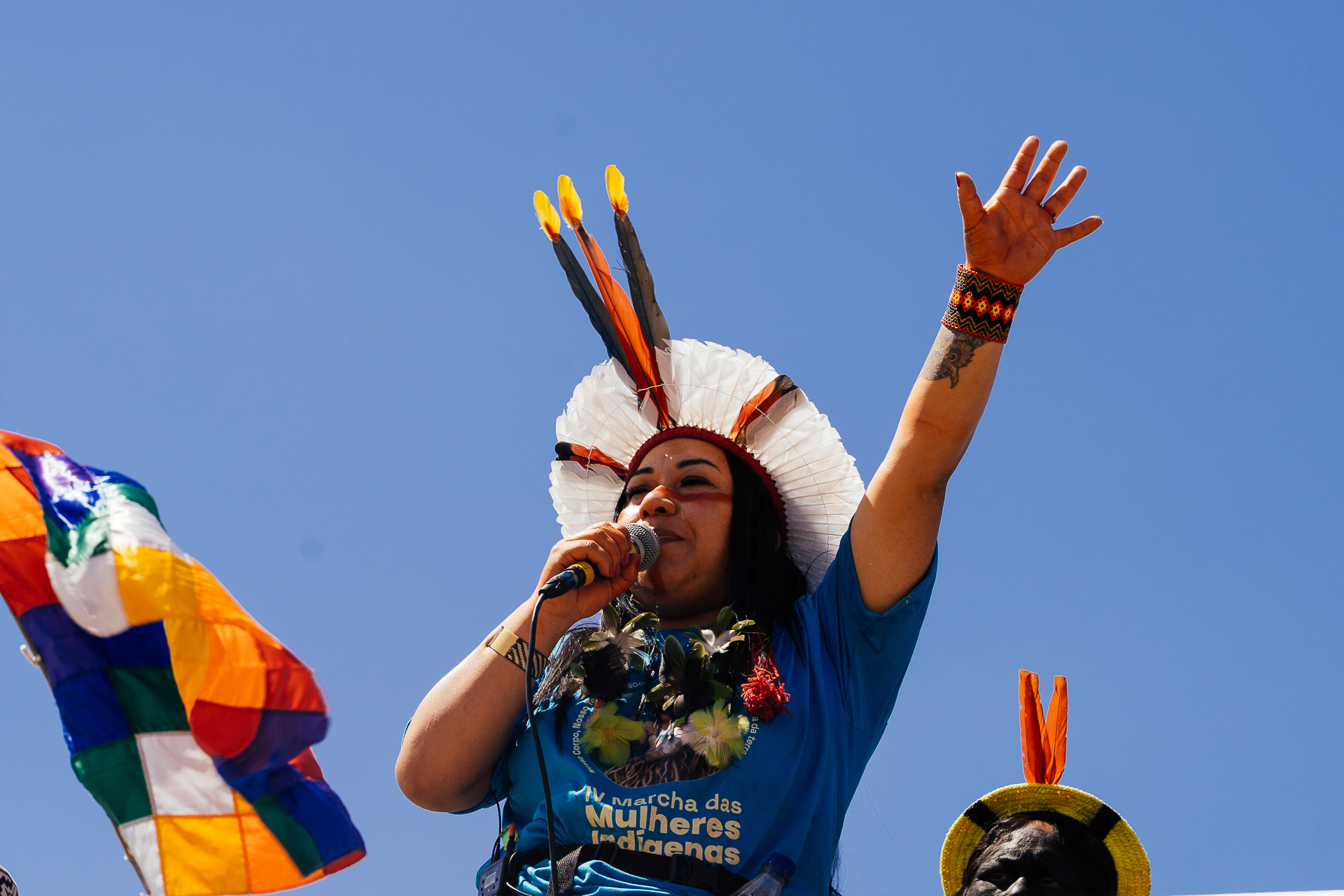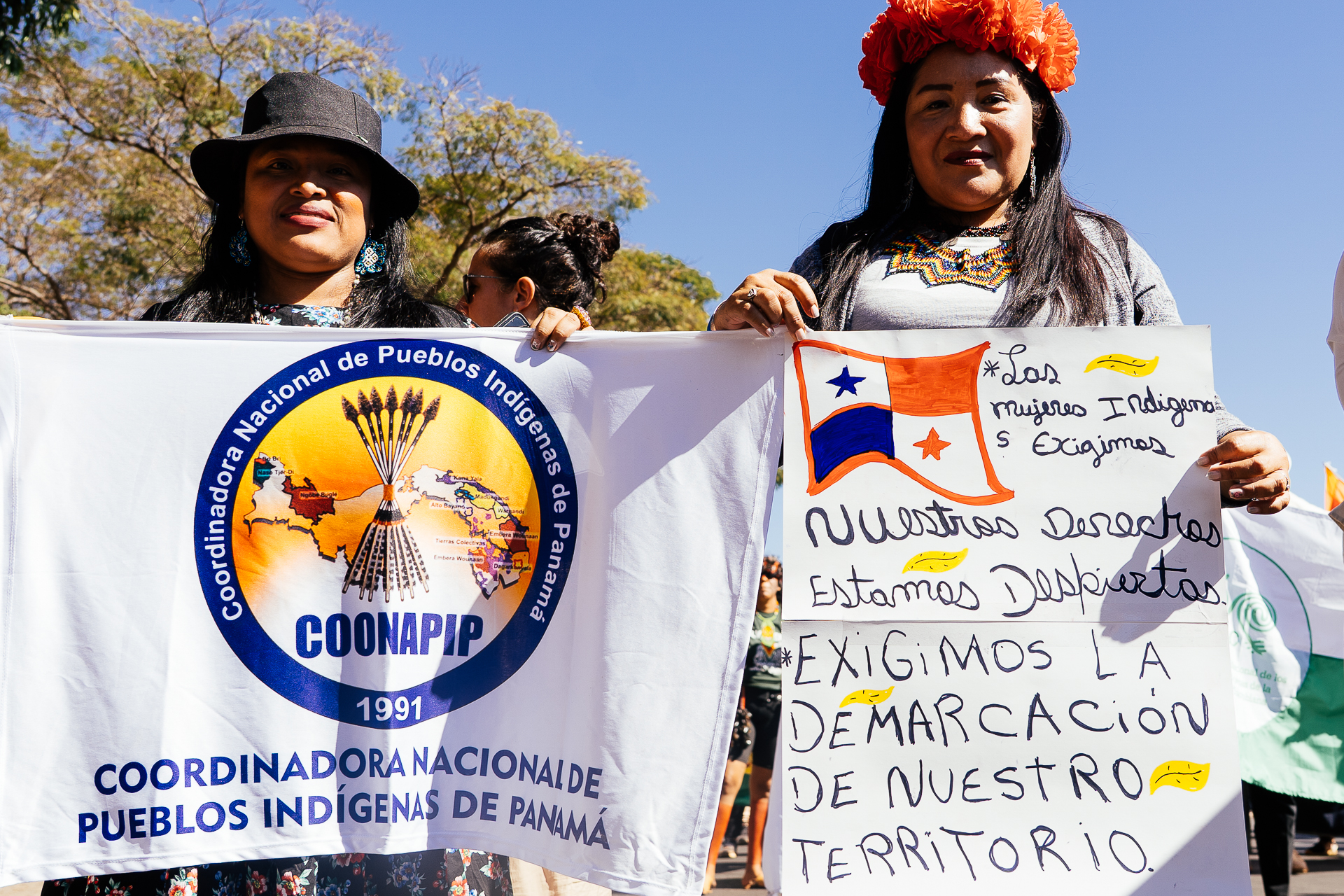2025-09-18
Written by Jupta Lilian Itoewaki and Robervone Nascimento, Programme Officers at Tenure Facility
Brasília, early August. Five thousand Indigenous women step into the streets, filling the capital with chants and ancestral power. For a week, the city is transformed—no longer just the seat of government, but a living stage for one of Brazil’s most urgent movements.
This is the fourth Indigenous Women’s March, organised with the theme “Our Bodies, Our Territory: Guardians of the Planet for Healing the Earth.”
It is more than a march. It is a declaration of survival and vision.

Indigenous women marching in Brasilia for the Indigenous Women March led by ANMIGA - Photo credit: Bahia Flores Pacheco/ TINTA
The stakes
Brazil’s 1.7 million Indigenous Peoples live across 809 recognised territories covering nearly 119 million hectares—almost all in the Amazon. These forests are the planet’s lungs: they store carbon in their trunks, roots, leaves, and soil, acting as natural climate stabilisers for the world.
And yet, many of these territories lack demarcation. Without legal recognition and protection of their boundaries, these areas—and the communities who live there—are vulnerable to land grabs, deforestation, harmful policy developments, and violence.
That is why the women march. They voice clear and urgent demands to the Brazilian government:

Sueli Kej Kaingang, Semilla Indigenous woman and member of ANMIGA. Photo credit: Bahia Flores Pacheco/TINTA.
“Our bodies, our territory”
The march’s 2025 theme captures an ancestral truth: women’s bodies and the land are inseparable. When the land is violated, the body is harmed. When the body is harmed, the land suffers. Protecting one means protecting the other.
This worldview weaves together ecology, care, self-defence, and healing—both individual and collective. To promote this thinking, the march hosted the National Conference of Indigenous Women for the first time. Participants collectively debated strategies and developed proposals. Out of this space, Brazil’s first-ever National Policy for Indigenous Women is now taking shape.
A historic shift
The march has grown since its first edition in 2019, when Indigenous women declared their voices could no longer be silenced. Every two years since, they have returned, filling Brasília with banners and the press of voices. But 2025 marked a milestone.
For the first time, many of the marchers saw women like themselves at the highest levels of government, including Sonia Guajajara, Brazil’s minister of Indigenous Peoples; Joenia Wapichana, president of the National Indigenous Peoples Foundation (FUNAI); Célia Xakriabá, federal deputy; and Sinea do Vale, co-president of the International Indigenous Peoples’ Forum on Climate Change.
Their leadership represents a turning point—not only for Indigenous rights but also for how Brazil sees its role in the climate action. Indigenous women bring knowledge rooted in centuries of protecting forests, waters, and territories, linking the survival of their peoples with the survival of the planet itself.
The march has led to concrete changes. In August, President Luiz Inácio Lula da Silva announced the:

Indigenous women who joined the learning exchange organised and supported by Tenure Facility and TINTA, and took part in the Indigenous Women’s March in Brasília (4–8 August). Photo credit: Bahia Flores Pacheco
A movement without borders
The march also drew international participants. Supported by Tenure Facility and TINTA, delegations from Ecuador, Peru, Colombia, Bolivia, Panama, Suriname, Guyana, and beyond joined an international tent referred to as the “ancestral space of global resistance.” Alongside Brazilian organisations such as the Union of Indigenous Women of the Brazilian Amazon (UMIAB) and the National Coordination of Ancestral Indigenous Women Warriors (ANMIGA), they shared strategies, exchanged experiences, and built alliances across languages and borders.
Other international participants included Tenure Facility and TINTA partners such as:
This momentum built on the Women Guardians of Mother Earth gathering, held in December 2024 on the outskirts of Santa Cruz, Bolivia. Over three days, around 50 Indigenous women leaders from across Latin America came together to share their experiences on women’s participation and leadership in territorial governance.
In an atmosphere of solidarity and shared struggle, participants reflected on how women carry and pass down ancestral knowledge, safeguarding their territories and cultures while meeting the needs of their families, communities, and lands. The gathering sparked hope and concrete opportunities for collaboration—locally, nationally, and regionally. The Indigenous women made a shared commitment to align strategies ahead of COP 30 in Belém, aiming to present a joint position that reflects their territories’ reality.

Jenifer Concepcion and Griselda Mecha (COONAPIP) at the Indigenous Women’s March in Brasilia. Photo credit: Bahia Flores Pacheco/ TINTA
For Tenure Facility and TINTA, the learning journey is central. Co-hosting this exchange with partners, including CNAMIB and the International Indigenous Women’s Forum (FIMI), supported Indigenous women to strengthen advocacy, refine strategies, and advance territorial governance from a gender perspective. These encounters are part of a broader process that expands networks, builds political strength, and makes Indigenous women’s leadership more visible in decision-making arenas at every level.
Together, the march in Brasília and the Bolivia learning journey form part of the same roadmap—one that recognises Indigenous women as defenders of their lands and as guardians of the planet, shaping policy and practice in the lead-up to COP 30 and beyond.
The road ahead
The Indigenous Women’s March concluded with a powerful ceremony: delivering the “Letter for Life and Body-Territories (Carta pela Vida e pelos Corpos-Territórios)” to Brazil’s Congress. This collective document contains 49 proposals, among them a demand for Indigenous Peoples’ land demarcation to be recognised under Brazil’s official climate policy.
The march may be over, but the work continues. It gains further momentum in ministries drafting policy; in international negotiations; and in the daily lives of women defending their lands, their languages, their knowledge, their future.
The message from the march in Brasília is clear: this struggle is not just about territory. It is about life itself.
And the question now—for governments, allies, and funders—is not why they marched. Rather, what commitments will be made on the road to COP 30 to ensure Indigenous women’s voices shape the future of our planet?
Other Blog Posts
Categories: